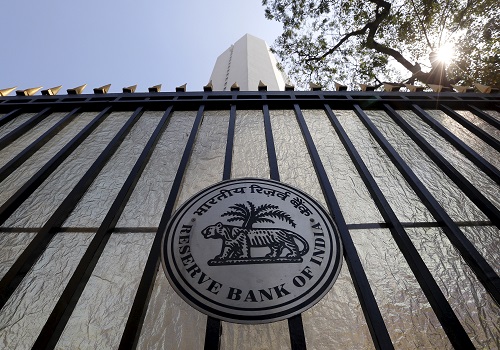Turmeric trading range for the day is 16498-17114 - Kedia Advisory

Follow us Now on Telegram ! Get daily 10 - 12 important updates on Business, Finance and Investment. Join our Telegram Channel
Gold
Gold surged by 1.26% to settle at 69799, buoyed by mounting concerns surrounding inflation and geopolitical tensions, which bolstered demand for the precious metal as a hedge. Despite apprehensions regarding a potential delay in U.S. interest rate cuts and the uptrend in Treasury yields, bullion traders remained undeterred, focusing instead on gold's safe-haven appeal amidst ongoing turmoil, notably Ukraine's attacks on Russia's oil infrastructure. Federal Reserve policymakers' contemplation of three U.S. rate cuts this year provided additional support for gold, despite recent economic data indicating resilience in the manufacturing sector and triggering fears of resurging inflation due to rising raw materials prices. Moreover, global central banks continued to bolster their gold reserves, with reported increases of 19t in February. Notably, the People’s Bank of China led the acquisitions, adding 12t to its reserves, marking the 16th consecutive month of growth. The National Bank of Kazakhstan also contributed to the trend, raising its reserves by 6t, while the Reserve Bank of India reported a 6t increase, further elevating its total holdings. From a technical standpoint, the gold market witnessed fresh buying momentum, indicated by a 1.54% increase in open interest, settling at 24528. Concurrently, prices surged by 871 rupees. Looking ahead, gold is poised to find support at 69240, with a potential downside target of 68680. Conversely, resistance is anticipated at 70140, with a breakout potentially leading to a test of 70480.
Trading Ideas:
* Gold trading range for the day is 68680-70480.
* Gold prices extended a record run as concerns of rising inflation boosted demand.
* Gold continues to receive safe-haven flows as Ukraine continues to attack Russia's oil infrastructure.
* Global central bank gold reserves rose by 19t in February, marking the ninth consecutive month of growth.
Silver
Silver prices surged by 2.56% yesterday, closing at 79,011, driven by heightened safe-haven demand amid escalating geopolitical tensions in the Middle East and Ukraine. This geopolitical uncertainty has bolstered investor interest in precious metals like silver, known for their role as safe-haven assets during times of instability. Concerns about the health of the U.S. economy were further compounded by the latest data from the Institute for Supply Management, which indicated a loss of momentum in the service sector. The Services Purchasing Managers Index dropped to 51.4%, below expectations, suggesting a slowdown in economic activity. Federal Reserve officials' remarks added to the market's uncertainty. Federal Reserve Bank of San Francisco President Mary Daly indicated a possibility of three interest-rate cuts this year, contingent upon various economic factors. Federal Reserve Bank of Cleveland President Loretta Mester also hinted at potential rate cuts but emphasized the importance of confirming such moves with data. The Silver Institute's bullish outlook for 2024 contributed to the positive sentiment surrounding silver. They anticipate a potential surge in prices to 10-year highs, driven by strong global demand expected to reach 1.2 billion ounces, the second-highest on record. From a technical standpoint, the market experienced fresh buying interest, with a 5.25% increase in open interest, settling at 28,736 contracts. Prices rose by 1,975 rupees. Currently, silver is finding support at 77,735, with further support at 76,460 levels. Resistance is anticipated at 79,740, with a potential move above leading to testing 80,470 levels.
Trading Ideas:
* Silver trading range for the day is 76460-80470.
* Silver gains fueled by geopolitical tensions in the Middle East and Ukraine intensified.
* The health of the U.S. economy is becoming increasingly muddled as the service sector continues to lose momentum.
* Fed’s Daly said she believes three interest-rate cuts this year is a "reasonable" expectation
Crude oil
Crude oil rallied by 1.2% to settle at 7162 as investors grappled with supply risks stemming from Ukrainian attacks on Russian refineries and the potential for further escalation in Middle East conflicts. OPEC+ ministers opted to maintain current output cuts in their latest meeting, refraining from fresh policy recommendations after extending production cuts until June the previous month. This decision, coupled with escalating geopolitical tensions, prompted Bank of America (BofA) Global Research to revise its 2024 Brent and WTI oil price forecasts upwards, projecting average prices of $86 and $81 per barrel respectively for the year, with peak prices anticipated around $95 per barrel during the summer. On the inventory front, the Energy Information Administration (EIA) reported a mixed picture for U.S. crude stocks. While crude inventories rose by 3.2 million barrels to 451.4 million barrels, stocks at the Cushing, Oklahoma, delivery hub decreased by 377,000 barrels. Additionally, refinery crude runs declined by 35,000 barrels per day. However, gasoline inventories experienced a significant drawdown, falling by 4.3 million barrels to 227.8 million barrels, surpassing expectations for an 800,000-barrel decrease. From a technical perspective, the crude oil market saw fresh buying interest, indicated by a substantial 33.02% increase in open interest, settling at 10793. Concurrently, prices climbed by 85 rupees. Looking ahead, crude oil is likely to find support at 7095, with a potential downside target of 7028. On the upside, resistance is expected at 7210, with a breakout possibly leading to a test of 7258.
Trading Ideas:
* Crudeoil trading range for the day is 7028-7258.
* Crude oil prices extended gains as investors mulled supply risks stemming from Ukrainian attacks on Russian refineries.
* OPEC+ ministers made no changes to current output cuts in a meeting.
* BofA hikes 2024 oil forecasts on tighter supply, geopolitical risks
Natural gas
Natural gas prices faced downward pressure yesterday, settling at 155.3, marking a decline of -0.83%. This drop was primarily attributed to revised forecasts indicating a smaller output decline, ample gas storage levels, and expectations of milder weather in the coming week. Despite expectations for record-high U.S. gas consumption in 2024, production is anticipated to decline for the first time since the COVID-19 pandemic in 2020, according to the U.S. Energy Information Administration's latest outlook. Output has already decreased by around 8% since the beginning of the year, with energy firms such as Eqt and Chesapeake Energy delaying well completions and reducing drilling activities. Financial firm LSEG reported a decline in gas output in the Lower 48 U.S. states, with April's average down to 98.6 billion cubic feet per day (bcfd) compared to March's 100.8 bcfd. Meteorologists forecasted colder-than-normal weather across the Lower 48 until April 7, followed by a warmer-than-normal period from April 8-18. As seasonally warmer weather approaches, LSEG projected a decrease in gas demand in the Lower 48, including exports, from 103.9 bcfd this week to 102.5 bcfd next week. From a technical perspective, the market witnessed fresh selling, with a 1% increase in open interest, settling at 51,824 contracts. Prices declined by -1.3 rupees. Natural gas is currently finding support at 153.3, with potential further support at 151.4 levels. Resistance is anticipated at 158.5, with a potential move above leading to testing 161.8 levels.
Trading Ideas:
* Naturalgas trading range for the day is 151.4-161.8.
* Natural gas eased on revised forecasts calling for a smaller output decline
* Output has been down by around 8% since the start of the year due to delayed well completions.
* Gas output in Lower 48 states has fallen to an average of 98.6 billion cubic feet per day in April.
Copper
Copper prices surged by 2.78% to settle at 790.65, driven by robust economic data from China that countered concerns of weakening demand from the world's largest consumer of the metal. Both the official and Caixin Purchasing Managers' Index (PMI) readings in China indicated expansion in factory activity for March, surpassing market expectations. This positive momentum suggests a potential turnaround in the manufacturing sector after facing challenges that dampened demand for base metals. Additionally, the outlook for copper prices remained supported by expectations of reduced supply, as Chinese copper smelters moved towards implementing a joint output cut amidst lower ore supplies. However, despite these factors, factory bidding remained subdued, leading to a significant increase in copper stocks by 5,000 tonnes to 290.3 thousand tonnes, reflecting tepid demand for physical copper. On the global front, the ICSG reported an 84,000 metric tons surplus in the refined copper market for January, compared to a 27,000 metric tons surplus in December. Adjusted for changes in inventory in Chinese bonded warehouses, the surplus in January stood at 84,000 metric tons compared to 22,000 metric tons in December, indicating a significant surplus in the market. From a technical perspective, the copper market witnessed fresh buying interest, indicated by a 7.14% increase in open interest, settling at 4740. Concurrently, prices surged by 21.35 rupees. Looking ahead, copper is anticipated to find support at 776.4, with potential downside testing of 762. On the upside, resistance is likely at 798.3, with a breakout possibly leading to a test of 805.8.
Trading Ideas:
* Copper trading range for the day is 762-805.8.
* Copper rose amid stronger-than-expected economic data from China.
* Both the official and Caixin PMIs in China pointed to an expansion in factory activity during March
* Prices also remained supported by the outlook of lower supply as Chinese copper smelters moved closer to a joint output cut amid lower ore supplies.
Zinc
Zinc prices surged by 2.16% yesterday, closing at 224.85, fueled by robust factory data from China which triggered buying activity. Manufacturing activity in China expanded for the first time in six months in March, with new export orders showing growth after 11 consecutive months of contraction. The positive sentiment was further supported by growing expectations of an interest rate cut by the European Central Bank and escalating tensions between Russia and Ukraine, which lifted the commodity market as a whole. Despite expectations of increased production in May, concerns arose due to the drought situation in Yunnan, which may bring uncertainty to supply dynamics. However, the traditional peak season and continued policy efforts to stimulate demand have boosted operating rates in various processing sectors. In February, China's aluminium output reached 3.333 million metric tons, marking a 7.81% year-on-year increase. Although domestic daily average aluminium output remained flat month-on-month, downstream aluminum processing companies experienced closures or reduced production during the Chinese New Year holidays. Additionally, a Japanese aluminium buyer agreed to pay a premium of $145 per metric ton over the benchmark price for shipments in April to June, representing a substantial 61% increase from the current quarter. From a technical standpoint, the market witnessed fresh buying interest, with a 2.79% increase in open interest, settling at 3,276 contracts. Prices rose by 4.75 rupees. Zinc is currently finding support at 220.4, with further support at 216 levels. Resistance is anticipated at 227.3, and a breakthrough could lead to testing 229.8 levels.
Trading Ideas:
* Zinc trading range for the day is 216-229.8.
* Zinc gains as strong factory data from China triggered buying.
* Support also seen amid concerns over slow recovery in production in China's Yunnan province.
* China’s manufacturing activity expanded for the first time in six months in March
Aluminium
Aluminium prices surged by 2.87% to settle at 218.75, fueled by several supportive factors across global markets. Stronger-than-expected economic data from China provided a significant boost, countering apprehensions of weakening demand from the world's largest consumer. Additionally, U.S. manufacturing expanded for the first time in 1-1/2 years in March, signaling a potential rebound in industrial activity and bolstering sentiment towards aluminium. Geopolitical tensions, particularly between Russia and Ukraine, further lifted commodity markets, including aluminium. Moreover, growing expectations of an interest rate cut by the European Central Bank added to the positive sentiment, driving investors towards commodities. Fundamentally, while expectations for increased production in May persist, uncertainties loom due to the drought situation in Yunnan, which may impact supply. However, the traditional peak season and continuous policy efforts to stimulate demand have boosted operating rates across various processing sectors. In terms of production, China's aluminium output rose by 7.81% year-on-year in February, with domestic smelters maintaining steady operations. However, an aluminium smelter in Inner Mongolia faced production disruptions due to a power outage, potentially affecting output in March. Technically, aluminium witnessed fresh buying interest, indicated by a 1.17% increase in open interest, settling at 3708. Concurrently, prices rose by 6.1 rupees. Looking ahead, aluminium is expected to find support at 214.4, with potential downside testing of 210.1. On the upside, resistance is likely at 221, with a breakout potentially leading to a test of 223.3.
Trading Ideas:
* Aluminium trading range for the day is 210.1-223.3.
* Aluminium gains as higher premiums Japanese buyers having to pay boosted sentiment.
* Support also seen amid stronger-than-expected economic data from China
* U.S. manufacturing expanded for the first time in 1-1/2 years in March.
Cotton
Cotton candy prices experienced a decline of -0.42% yesterday, settling at 62,220, primarily influenced by upward revisions in cotton production estimates by key organizations such as the Cotton Association of India (CAI) and the Cotton Corporation of India (CCI). CAI raised its cotton production estimate for the current season to 309.70 lakh bales, while CCI reported procurement of 32.81 lakh bales so far this season. Additionally, the Southern India Mills’ Association (SIMA) urged textile mills to refrain from panic buying amidst a recent surge in cotton prices. Increased supply expectations globally, including higher production estimates in India and Australia, contributed to the downward pressure on cotton prices. However, despite higher global production and trade, ending stocks are projected to be lower, indicating potential tightening of supply-demand dynamics. On the technical front, the cotton candy market witnessed fresh selling, with a 1.62% increase in open interest, settling at 439 contracts. Prices declined by -260 rupees. Currently, cotton candy is finding support at 62,100, with further support at 61,990 levels. Resistance is anticipated at 62,360, with a potential move above leading to testing 62,510 levels. Overall, cotton candy prices reflect a combination of factors including production estimates, demand-supply dynamics, and market sentiment. While increased supply expectations weigh on prices, concerns over tightening ending stocks could provide support in the near term. Market participants remain cautious amidst fluctuations in global production and consumption patterns, closely monitoring both domestic and international developments in the cotton market.
Trading Ideas:
* Cottoncandy trading range for the day is 61990-62510.
* Cotton dropped as CAI has revised its production estimates upwards to 309.70 lakh bales
* CCPC raised crop production for the current season to 323.11 lakh bales
* Cotton Australia raised its estimate for Australian production this year to "at least" 4.5 million bales
* In Rajkot, a major spot market, the price ended at 29135.8 Rupees dropped by -0.06 percent.
Turmeric
Turmeric prices surged by 1.72% to settle at 16828, driven by below-normal supplies and robust festive demand, setting a positive tone in the market. The impact of lower production was evident in reduced arrivals, with only about 9050 tonnes reaching major APMC markets in March 2024 compared to 18373 tonnes in the previous year. This supply tightness is expected to encourage stockists to purchase turmeric at every price dip, maintaining upward pressure on prices, especially with the onset of the festival season and wedding demand. Production is anticipated to decline by approximately 14% year-on-year due to reduced cultivation area and tumbling yields, projected to range between 9.2-9.5 lakh tonnes. Despite lower production, turmeric exports during April-January 2024 experienced a modest drop of 3.52%, with 131,662.92 tonnes exported compared to 136,468.59 tonnes in the same period last year. However, imports decreased significantly by 22.34% during the same period, indicating a balanced trade scenario. On the technical front, the turmeric market observed short-covering activities, with a notable 9% drop in open interest, settling at 9205, while prices surged by 284 rupees. Looking ahead, turmeric is expected to find support at 16664, with potential downside testing of 16498. Conversely, resistance is likely at 16972, with a breakout potentially leading to a test of 17114.
Trading Ideas:
* Turmeric trading range for the day is 16498-17114.
* Turmeric prices seen supported amid below normal supplies
* Festivals ahead in coming months and commencement of wedding season demand is likely to keep buyers engage.
* Production is likely to be dropped by about 14% Y-o-Y due to lower area under turmeric.
* In Nizamabad, a major spot market, the price ended at 16363.95 Rupees dropped by -0.18 percent.
Jeera
Jeera prices surged by 3.09% yesterday, closing at 24,190, driven by low-level buying after a recent drop in prices, despite concerns over increasing arrivals and supply pressure in the market. The influx of 10,000 to 12,000 bags of jeera daily in the Rajkot Mandi has outweighed demand, leading to market pressure. New arrivals have been observed in both Gujarat and Rajasthan, with significant increases in sowing areas attributed to favorable weather conditions. Gujarat is estimated to achieve a record production of 4.08 lakh tonnes, while Rajasthan's production has increased by 53%. Despite the rise in production, analysts anticipate a substantial increase in cumin exports, potentially reaching 14-15 thousand tonnes by February 2024. This projection follows a volatile period for cumin exports in 2023, where domestic price surges impacted export figures. However, with increased sowing areas in Gujarat and Rajasthan coupled with declining international cumin prices, a resurgence in exports is expected. However, jeera exports during April-January 2024 saw a significant decline of 25.33% compared to the same period in 2023, with only 109,097.06 tonnes exported. Nonetheless, January 2024 witnessed a notable rise in exports, increasing by 53.99% compared to January 2023. From a technical standpoint, the market experienced short covering, with a notable 10.42% decrease in open interest, settling at 2,115 contracts. Prices rose by 725 rupees. Currently, jeera is finding support at 23,740, with further support at 23,300 levels. Resistance is anticipated at 24,580, with a potential move above leading to testing 24,980 levels.
Trading Ideas:
* Jeera trading range for the day is 23300-24980.
* Jeera gains on low level buying after prices dropped as there is a possibility of further increase in arrivals pressure.
* There will be a huge increase in cumin exports, which will reach about 14-15 thousand tonnes in February 2024.
* New arrivals have started in Gujarat since last 20-25 days and new arrivals have started in Rajasthan also since last 15 days.
* In Unjha, a major spot market, the price ended at 24818.9 Rupees gained by 1.19 percent.
Views express by all participants are for information & academic purpose only. Kindly read disclaimer before referring below views. Click Here For Disclaimer












 320-x-100_uti_gold.jpg" alt="Advertisement">
320-x-100_uti_gold.jpg" alt="Advertisement">








